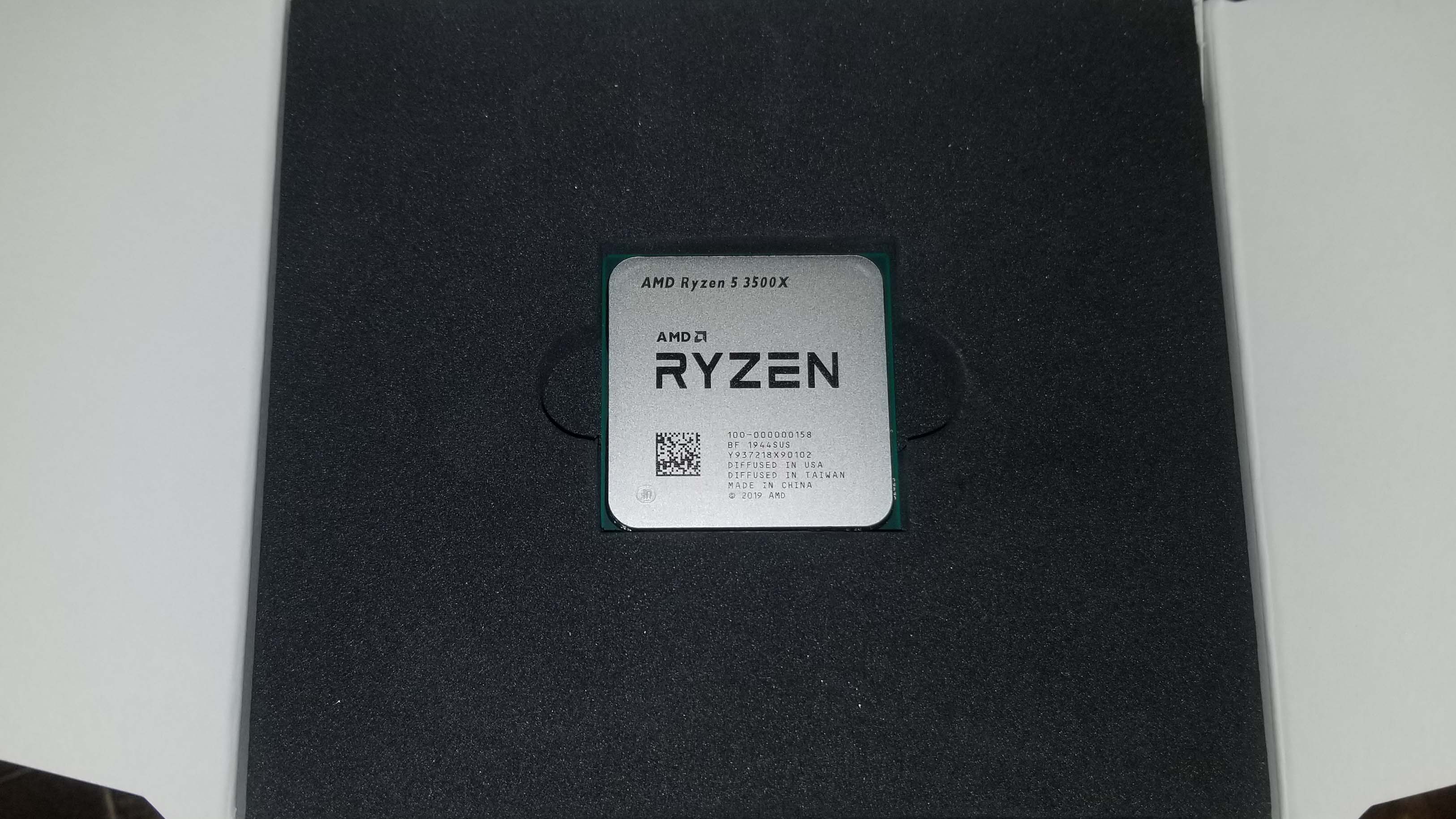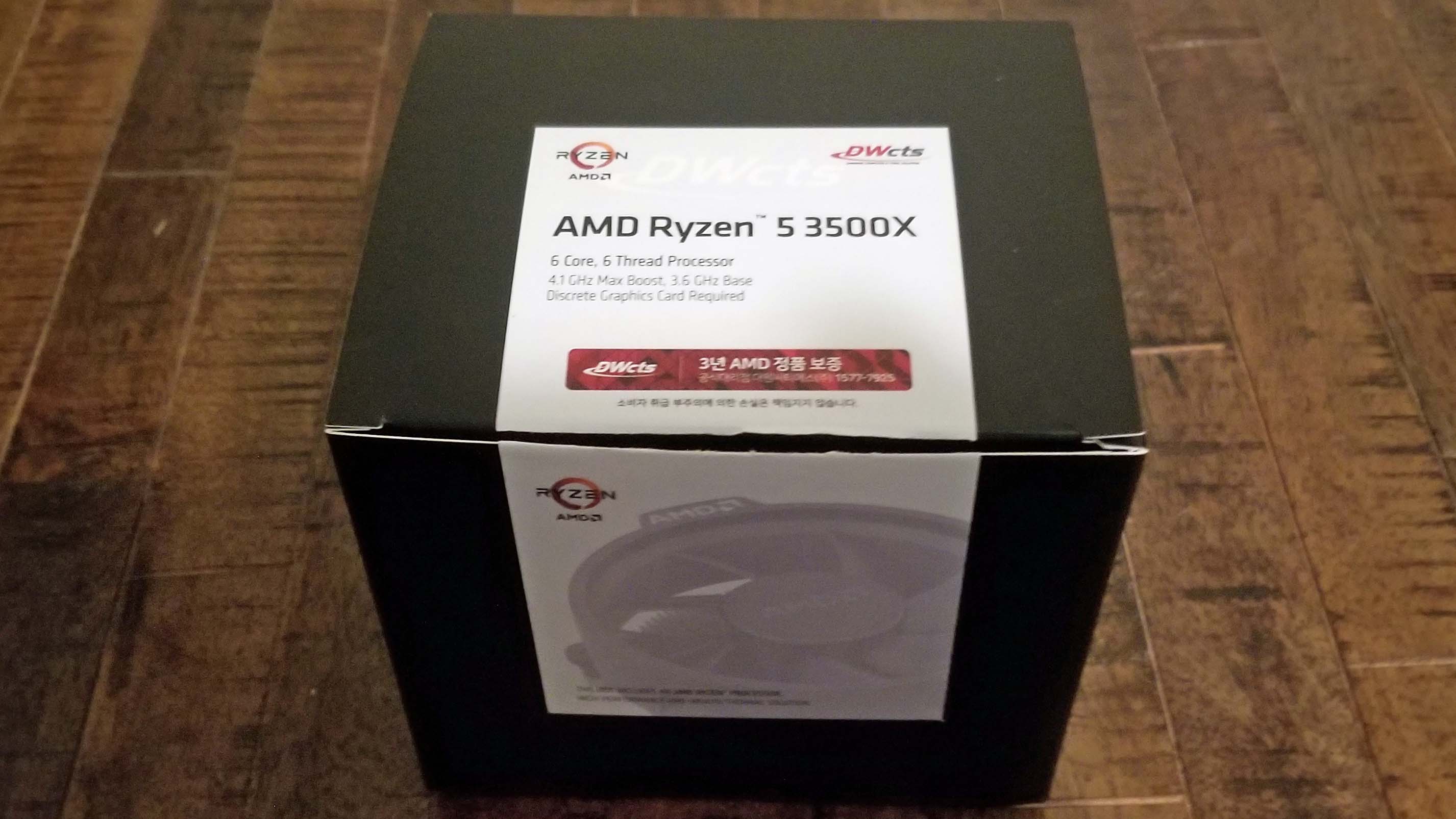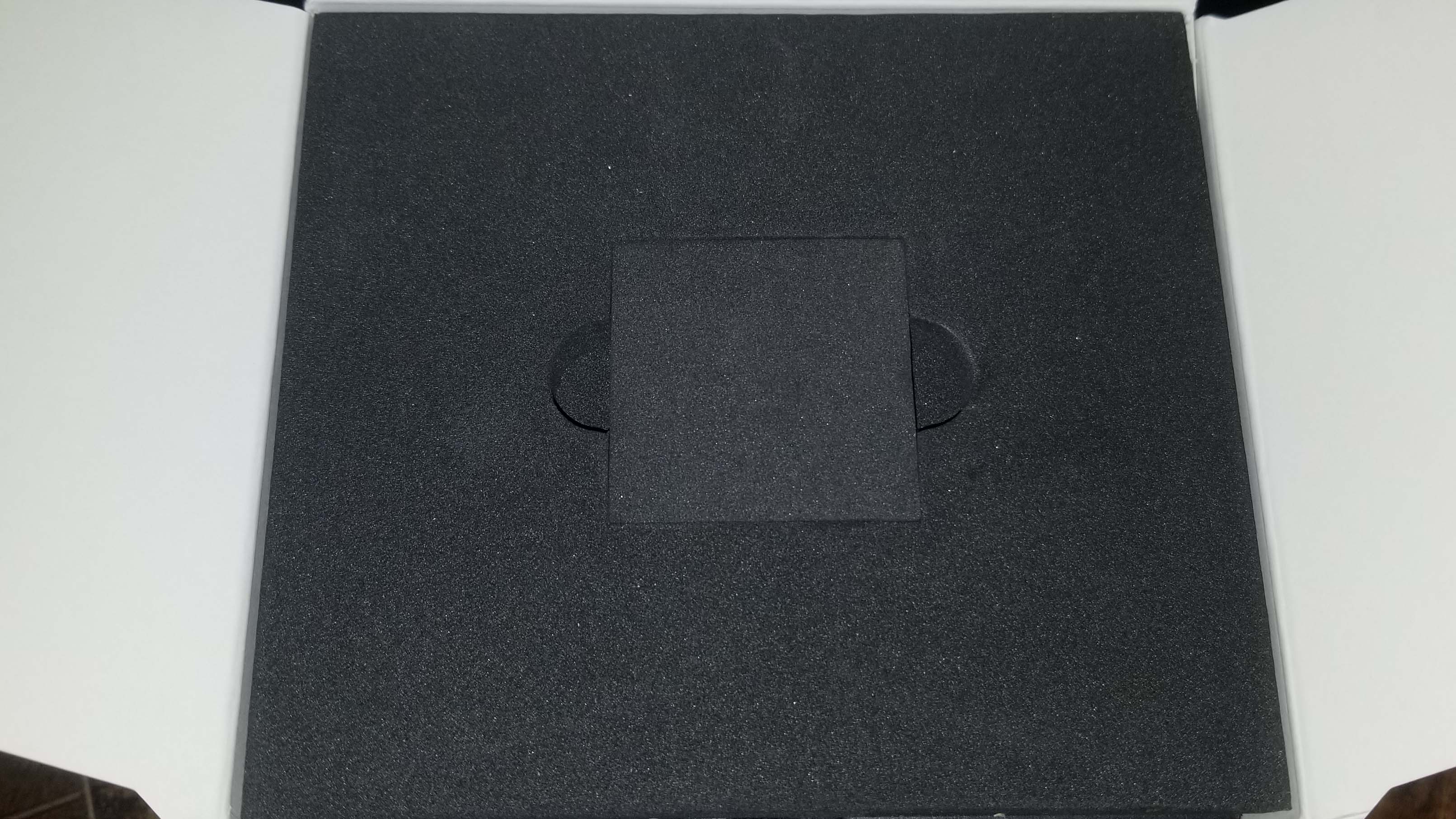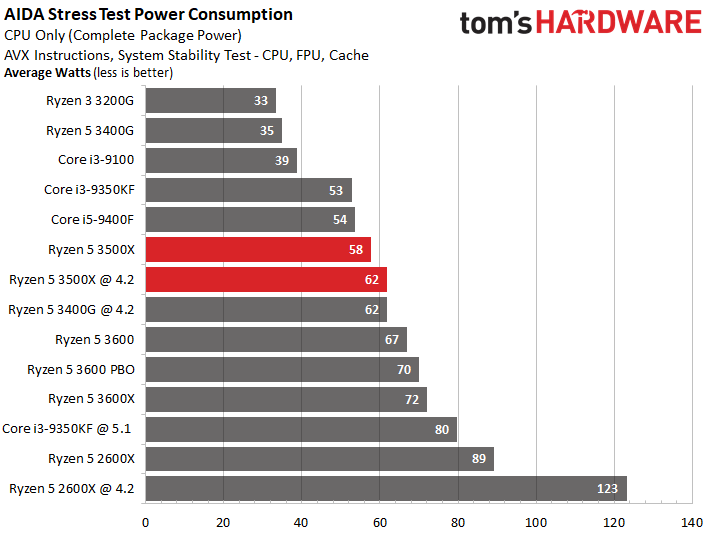Tom's Hardware Verdict
The AMD Ryzen 5 3500X is a solid chip for its target market and would make a nice addition for a collector, but enthusiasts should stick with AMD's retail models for the best mix of price and performance.
Pros
- +
Faster than comparable Ryzen models in some games
- +
PCIe 4.0
- +
Lower power consumption
Cons
- -
'Limited' to OEM and SI markets
- -
Reduced performance in threaded applications
- -
High pricing in grey market
Why you can trust Tom's Hardware
Today we have AMD's Ryzen 5 3500X, a processor that AMD designed specifically for the Chinese OEM and system integrator (SI) market, in for testing to determine if it can compete with the best CPUs for gaming or best CPUs for desktop applications. With six cores and threads, the Ryzen 5 3500X stands out among AMD's third-gen Ryzen stack as the only model without simultaneous multi-threading (SMT).
Like the Ryzen 9 3900 we took for a spin, this processor isn't intended for retail. Most customers will encounter this chip in pre-built systems, but you won't find these desktops competing against the best gaming PCs, because they are only available in China. However, various resellers offer the chip for stand-alone sales in Asia and India even though AMD lists it as China-only.
It isn't easy to keep unique chips out of enthusiast's hands, and you can score one if you're determined and patient enough through eBay for ~$190, though several sellers also carry the processor for ~$240. We even found these grey-market chips bundled with the Wraith Stealth cooler.
AMD's third-gen Ryzen series has proven to be a potent force in the retail market with its healthy serving of cores and threads, and the modular design affords opportunities for specialized designs to tackle various market segments. That makes lopping off SMT an easy option to tackle Intel's advantage in OEM markets, but pricing and access to integrated graphics are typically key to securing lucrative high-volume orders.
The AMD Ryzen 5 3500X comes without an integrated graphics engine, meaning its market is limited to systems with a discrete graphics card. That makes Intel's new graphics-less F-series processors its natural competitor. Even with a similar number of cores and threads, the AMD Ryzen 5 3500X offers better overall performance in both gaming and productivity apps than Intel's Core i5-9400F. However, we could say the same about AMD's other Ryzen 3000 series models that come with threading and offer a higher amount of performance. Unless you're looking for a neat collector's item, AMD's existing retail chips, or the looming Ryzen 3 series processors, are almost certainly the better option.
| Row 0 - Cell 0 | MSRP | Cores / Threads | Base / Boost GHz | TDP | L3 Cache | PCIe |
| Ryzen 9 3950X | $749 | 16 / 32 | 3.5 / 4.7 | 105W | 64MB | 16+4 Gen4 |
| Ryzen 9 3900X | $499 | 12 / 24 | 3.8 / 4.6 | 105W | 64MB | 16+4 Gen4 |
| Ryzen 9 3900 | N/A | 12 / 24 | 3.1 / 4.3 | 65W | 64MB | 16+4 Gen4 |
| Ryzen 7 3800X | $339 | 8 / 16 | 3.9 / 4.5 | 105W | 32MB | 16+4 Gen4 |
| Ryzen 7 3700X | $329 | 8 / 16 | 3.6 / 4.4 | 65W | 32MB | 16+4 Gen4 |
| Ryzen 5 3600X | $249 | 6 / 12 | 3.8 / 4.4 | 95W | 32MB | 16+4 Gen4 |
| Ryzen 5 3600 | $199 | 6 / 12 | 3.6 / 4.2 | 65W | 32MB | 16+4 Gen4 |
| Ryzen 5 3500X | ~$190 | 6 / 6 | 3.6 / 4.1 | 65W | 35MB | 16+4 Gen4 |
| Ryzen 3 3300X | $120 | 4 / 8 | 3.8 / 4.3 | 65W | 16MB | 16+4 Gen4 |
| Ryzen 3 3100 | $99 | 4 / 8 | 3.8 / 3.9 | 65W | 16MB | 16+4 Gen4 |
AMD Ryzen 5 3500X Specifications
| Model | Cores / Threads | Base Clock | Boost Clock | L3 Cache | TDP | PCIe | Memory Support | MSRP |
| AMD Ryzen 5 3600 | 6 / 12 | 3.6 GHz | 4.2 GHz | 32MB | 65W | 16+4 Gen4 | Dual DDR4-3200 | $199 |
| AMD Ryzen 5 3500X | 6 / 6 | 3.6 GHz | 4.1 GHz | 32MB | 65W | 16+4 Gen4 | Dual DDR4-3200 | ~$190 |
| Intel Core i5-9400F | 6 / 6 | 2.9 GHz | 4.1 GHz | 9MB | 65W | 16 Gen3 | Dual DDR4-2666 | $157 |
The AMD Ryzen 5 3500X slots in against the Intel Core i5-9400F, matching it core-for-core and thread-for-thread with its six-core design. However, as we noted in our Intel Core i5-9400F review, that CPU ticks at a 2.9 GHz base clock and . But the Ryzen 5 3500X comes with a higher 3.6 GHz base frequency. That should help offset Intel's per-core advantage in threaded workloads, and both chips come with a 4.1 GHz boost clock. That's the lowest boost speed of the Ryzen 3000 series lineup, and, as we'll cover below, that means you should treat overclocking a bit differently.
Like the other Ryzen 3000 chips, the AMD Ryzen 5 3500X comes with a 7nm compute die (with two disabled physical cores) paired with a 12nm I/O die. These two components come together into a single package that fits inside a 65W TDP envelope, making the chip physically identical to the 95W Ryzen 5 3600X. As such, the AMD Ryzen 5 3500X also looks nearly identical to the upstream Ryzen 5 3600, except it only comes with six threads operating across the six-core design. As we've often seen, processors without hyper-threading tend to perform better in some lightly-threaded workloads, so the lack of threading could help the AMD Ryzen 5 3500X in some tasks, like gaming.
Get Tom's Hardware's best news and in-depth reviews, straight to your inbox.
The AMD Ryzen 5 3500X comes with all of the trimmings we expect from the Ryzen 3000 series of processors, like support for the PCIe 4.0 interface that provides twice the I/O bandwidth of the PCIe 3.0 interface supported on Intel's chips. The chip also carries the same 65W TDP as the Core i5-9400F, but these values aren't directly comparable due to how the companies measure the value.
Like its Ryzen counterparts, the AMD Ryzen 5 3500X shares the same Zen 2 design that's etched into the 7nm process, so the feature set is largely the same. The chip comes with a fully unlocked ratio multiplier, meaning overclocking the CPU and memory is on the menu, support for dual-channel DDR4-3200 memory (varies based on DIMM population), and it drops into socket AM4 motherboards (support may vary by vendor). For now, you'll have to pair the chip with either an X570 motherboard that carries a higher price than we'd recommend for this class of chip, or discard PCIe 4.0 support in favor of a cheaper B450 or X470 motherboard. AMD has its B460 lineup coming soon that will slot in as a PCIe 4.0-capable value alternative. That class of board would make a better home for the 3500X.
.




The AMD Ryzen 5 3500X doesn't come with an official recommended selling price, but we ordered our chip for $180, though prices appear to have risen in the interim. Now you'll often see the processor listed for as high as $240, which isn't the best deal given that the Ryzen 5 3600, which comes with threading that enables better performance in heavier workloads like productivity applications, weighs in at $199.
Our Ryzen 5 3500X came in a spartan package compared to the typical Ryzen processors, though it does have an official AMD sticker sealing the package. Inside we see fairly standard fare, with the notable exception that the processor doesn't come inside the normal clear plastic carrier. Instead, the processor is nestled into the foam liner with a foam cover on top. We found a bundled 65W Wraith Spire cooler underneath the foam cover. This all-aluminum model is sufficient for stock cooling, but you might consider a beefier model for serious overclocking.
Test Systems and Overclocking Ryzen 5 3500X
AMD allows overclocking on all Ryzen 3000 SKUs, and the Ryzen 5 3500X is no exception. With the arrival of the Ryzen 3000 series chips, we switched over to AMD's auto-overclocking Precision Boost Overdrive (PBO) for the majority of our overclocking tests. That's because we typically can't manually dial in an all-core overclock that surpasses the single-core boost speed. In fact, we often end up 200 to 300 MHz below the single-core boost, which results in some performance losses in lightly-threaded apps. Overclocking isn't about taking losses on the performance front, and the automated PBO gives us the best of single- and all-core performance.
Here's where the AMD Ryzen 5 3500X is different, though. With a single-core boost frequency of only 4.1 GHz, the lowest of the Ryzen 3000 stack, our manual overclock should exceed the chip's out of the box specifications on all fronts.
And it did just that. We didn't encounter any surprises; the AMD Ryzen 5 3500X handles just like any other Ryzen 300 chip. We dialed in an all-core 4.2 GHz overclock with 1.41V and ticked over our XMP profile to DDR4-3600, all with a minimum of fuss.
The AMD Ryzen 5 3500X does come sans threading, which reduces power consumption compared to the 3600X that comes with the same number of cores but twice the threads. Even with the Ryzen 5 3500X's pared-back power consumption, Intel's Core i5-9400F still draws less power.
Relative to the 3600X, the AMD Ryzen 5 3500X's reduced power consumption equates to less heat generation, but we couldn't find any significant extra overclocking headroom as a result. As per usual, we're confined to the limits of the 7nm process.
In either case, now that we're ticking along at 100 MHz above the turbo frequency on all cores, let's get to testing.
| AMD Socket AM4 (X570/B450M/X370) | |
| Ryzen 5 3500X, Ryzen 5 3600X, Ryzen 5 3600X, Ryzen 5 2600X, Ryzen 5 3400G, Ryzen 3 3200G | |
| MSI MEG X570 Godlike / MSI X370 Xpower Gaming Titanium | |
| 2x 8GB G.Skill Flare DDR4-3200 | |
| Ryzen 3000 - DDR4-3200, DDR4-3600 | |
| Second-gen Ryzen - DDR4-2933, DDR4-3466 | |
| Intel LGA 1151 (Z390) | |
| Intel Core i5-9400F, Core i3-9350KF, Core i3-9100 | |
| MSI MEG Z390 Godlike / MSI MPG Z390 (iGPU) | |
| 2x 8GB G.Skill FlareX DDR4-3200 @ DDR4-2667 & DDR4-3600 | |
| All Systems | |
| Nvidia GeForce RTX 2080 Ti | |
| 2TB Intel DC4510 SSD | |
| EVGA Supernova 1600 T2, 1600W | |
| Windows 10 Pro (1903 - All Updates) | |
| Cooling | |
| Corsair H115i, Zhaoxin Stock Cooler |

Paul Alcorn is the Editor-in-Chief for Tom's Hardware US. He also writes news and reviews on CPUs, storage, and enterprise hardware.
-
refillable We have plenty of these in Indonesia, but I'd pass this for a 2600 or 1600AF. They're a bit cheaper and have more threads that would be useful once games starts to be optimized for 8C/16T CPUs.Reply -
gfg 2016 and AMD looked like they had the coffin bought .... but 2017 came and Ryzen appeared:Reply
Newly announced Ryzen 3 3100X and 3300X are worth $ D99 and $ D120 very comparable to a two-year-old Core i7 7700 that were worth 3-4 times more.
Ryzen 9 3950X 16/32 cores / threads from U $ DS750 which is the High End on desktop PC ... broke the floor to U $ D2000 processors from Intel professional workstations.
Thread Ripper 3990X 64 cores / 128 threads and 288 MB of total cache, forced Intel to completely surrender the crown of professional workstations, it seems Japan defeated in the second world war by the US in this sector, it has nothing at all to compete at this level against AMD.
Ryzen Mobile 4000: Ryzen 4900HS 8 cores / 16 threads 35W, integrated igpu comparable in power to a Geforce MX250, is in notebook in the price range of U $ D1400 and is equated with the Intel 10980HK 8/16 core CPU / 45W wires and comparable remaining specifications where the price far exceeds U $ D2500 ... * Intel PCI-E 4.0 vs 3.0 in the entire range of PCs and more connection lines in each product range vs. Intel.
On the server side, Epyc is an excellent processor with a top of the range of 64/128 cores and 128 PCI-E 4.0 lines, although it is difficult to overcome the root part of Intel in this regard. Still, AMD already has contracts for the world's fastest supercomputers where EL Capitan with a theoretical maximum capacity of 2.0 Exaflops and Frontier of 1.5 Exaflops outperforms all other Supercomputer projects. Intel has Aurora programmed for "only" 1.0 Exaflop, meaning "1 Exaflop" for "1 million Teraflops". In no case is Nvidia part of this panorama and at the moment it does not have new contracts of this scale in the future, although it is currently the leader in most of the top500. * And there are new Ryzen 3 CPU and RDNA 2 GPU architectures out by the end of the year, the future looks bright if things get right, and Intel continues on the current timeline.
And finally out of the PC world, next-gen consoles have comparable specs to a Ryzen 7 3700 and Radeon 5700XT with slightly lower clocks, an improvement especially in CPUs that was heavily needed to upgrade the graphics-quality floor to current game titles, by the fact of sharing PC and Console platforms and the console has always limited PCs in recent years. I summarize ... Thanks AMD !, Thanks Advanced Micro Device !!! -
Zarax What would be extremely interesting is a review of how AMD HEDT chips fare in gaming with SMT disabled.Reply
It was done for the 2000 series and it would be interesting to repeat the test for the 3000 too. -
RodroX Nice review, too bad the price is soo high. I guess for an all around office PC it will be a very powerfull chip, but thats it. If the price was around U$100, it could be a nice budget CPU for some games.Reply
I feel both the Ryzen 5 3500X and the Core i3 9350KF are kinda pointless. The first is too expensive and the lack of HT turn it sorta useless against the Ryzen 5 1600AF and 2600, heck for the same price you could get a Ryzen 5 3600. The second it only make sense if you are going to OC and for that you need to dish out a lot of cash for high end motherboard, so you are better off getting a budget B450 mobo and a higher core and threads Ryzen CPU. -
hennes "Intel Core i5-9400F review, that CPU ticks at a 2.9 GHz base clock and . But "Reply
Half sentence?
" the AMD Ryzen 5 3500X handles just like any other Ryzen 300 chip. "
3000?
Otherwise a fun read :) -
panathas The B460 is a new upcoming INTEL chipset and not an AMD one. The correct AMD chipset is the B450 or the new B550.Reply -
mdd1963 With the rather noted (and surprisingly high,IMO) placing of the 9350K here, it's almost like someone went out of their way to find the last 5-6 semi-popular games that still did quite well on 4 threads, even at 1% lows...and used just those. :)Reply
